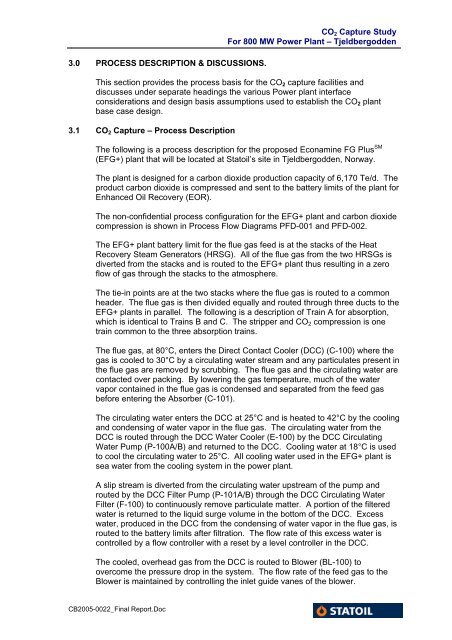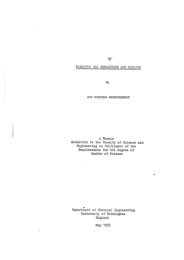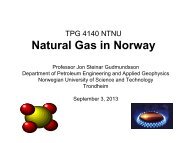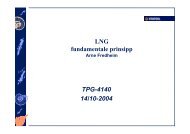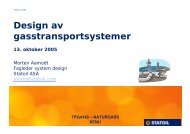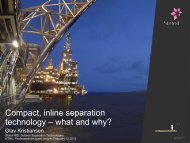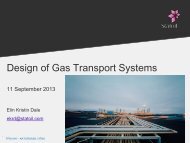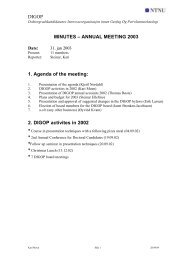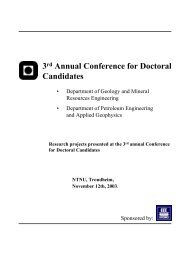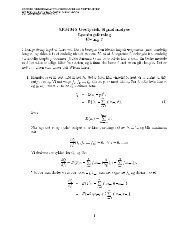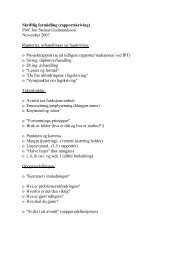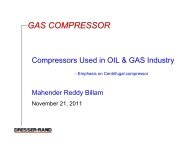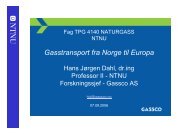for the proposed 800 MW Combined Cycle Power Plant ...
for the proposed 800 MW Combined Cycle Power Plant ...
for the proposed 800 MW Combined Cycle Power Plant ...
You also want an ePaper? Increase the reach of your titles
YUMPU automatically turns print PDFs into web optimized ePapers that Google loves.
3.0 PROCESS DESCRIPTION & DISCUSSIONS.<br />
CO 2 Capture Study<br />
For <strong>800</strong> <strong>MW</strong> <strong>Power</strong> <strong>Plant</strong> – Tjeldbergodden<br />
This section provides <strong>the</strong> process basis <strong>for</strong> <strong>the</strong> CO 2 capture facilities and<br />
discusses under separate headings <strong>the</strong> various <strong>Power</strong> plant interface<br />
considerations and design basis assumptions used to establish <strong>the</strong> CO 2 plant<br />
base case design.<br />
3.1 CO 2 Capture – Process Description<br />
The following is a process description <strong>for</strong> <strong>the</strong> <strong>proposed</strong> Econamine FG Plus SM<br />
(EFG+) plant that will be located at Statoil’s site in Tjeldbergodden, Norway.<br />
The plant is designed <strong>for</strong> a carbon dioxide production capacity of 6,170 Te/d. The<br />
product carbon dioxide is compressed and sent to <strong>the</strong> battery limits of <strong>the</strong> plant <strong>for</strong><br />
Enhanced Oil Recovery (EOR).<br />
The non-confidential process configuration <strong>for</strong> <strong>the</strong> EFG+ plant and carbon dioxide<br />
compression is shown in Process Flow Diagrams PFD-001 and PFD-002.<br />
The EFG+ plant battery limit <strong>for</strong> <strong>the</strong> flue gas feed is at <strong>the</strong> stacks of <strong>the</strong> Heat<br />
Recovery Steam Generators (HRSG). All of <strong>the</strong> flue gas from <strong>the</strong> two HRSGs is<br />
diverted from <strong>the</strong> stacks and is routed to <strong>the</strong> EFG+ plant thus resulting in a zero<br />
flow of gas through <strong>the</strong> stacks to <strong>the</strong> atmosphere.<br />
The tie-in points are at <strong>the</strong> two stacks where <strong>the</strong> flue gas is routed to a common<br />
header. The flue gas is <strong>the</strong>n divided equally and routed through three ducts to <strong>the</strong><br />
EFG+ plants in parallel. The following is a description of Train A <strong>for</strong> absorption,<br />
which is identical to Trains B and C. The stripper and CO 2 compression is one<br />
train common to <strong>the</strong> three absorption trains.<br />
The flue gas, at 80°C, enters <strong>the</strong> Direct Contact Cooler (DCC) (C-100) where <strong>the</strong><br />
gas is cooled to 30°C by a circulating water stream and any particulates present in<br />
<strong>the</strong> flue gas are removed by scrubbing. The flue gas and <strong>the</strong> circulating water are<br />
contacted over packing. By lowering <strong>the</strong> gas temperature, much of <strong>the</strong> water<br />
vapor contained in <strong>the</strong> flue gas is condensed and separated from <strong>the</strong> feed gas<br />
be<strong>for</strong>e entering <strong>the</strong> Absorber (C-101).<br />
The circulating water enters <strong>the</strong> DCC at 25°C and is heated to 42°C by <strong>the</strong> cooling<br />
and condensing of water vapor in <strong>the</strong> flue gas. The circulating water from <strong>the</strong><br />
DCC is routed through <strong>the</strong> DCC Water Cooler (E-100) by <strong>the</strong> DCC Circulating<br />
Water Pump (P-100A/B) and returned to <strong>the</strong> DCC. Cooling water at 18°C is used<br />
to cool <strong>the</strong> circulating water to 25°C. All cooling water used in <strong>the</strong> EFG+ plant is<br />
sea water from <strong>the</strong> cooling system in <strong>the</strong> power plant.<br />
A slip stream is diverted from <strong>the</strong> circulating water upstream of <strong>the</strong> pump and<br />
routed by <strong>the</strong> DCC Filter Pump (P-101A/B) through <strong>the</strong> DCC Circulating Water<br />
Filter (F-100) to continuously remove particulate matter. A portion of <strong>the</strong> filtered<br />
water is returned to <strong>the</strong> liquid surge volume in <strong>the</strong> bottom of <strong>the</strong> DCC. Excess<br />
water, produced in <strong>the</strong> DCC from <strong>the</strong> condensing of water vapor in <strong>the</strong> flue gas, is<br />
routed to <strong>the</strong> battery limits after filtration. The flow rate of this excess water is<br />
controlled by a flow controller with a reset by a level controller in <strong>the</strong> DCC.<br />
The cooled, overhead gas from <strong>the</strong> DCC is routed to Blower (BL-100) to<br />
overcome <strong>the</strong> pressure drop in <strong>the</strong> system. The flow rate of <strong>the</strong> feed gas to <strong>the</strong><br />
Blower is maintained by controlling <strong>the</strong> inlet guide vanes of <strong>the</strong> blower.<br />
CB2005-0022_Final Report.Doc


